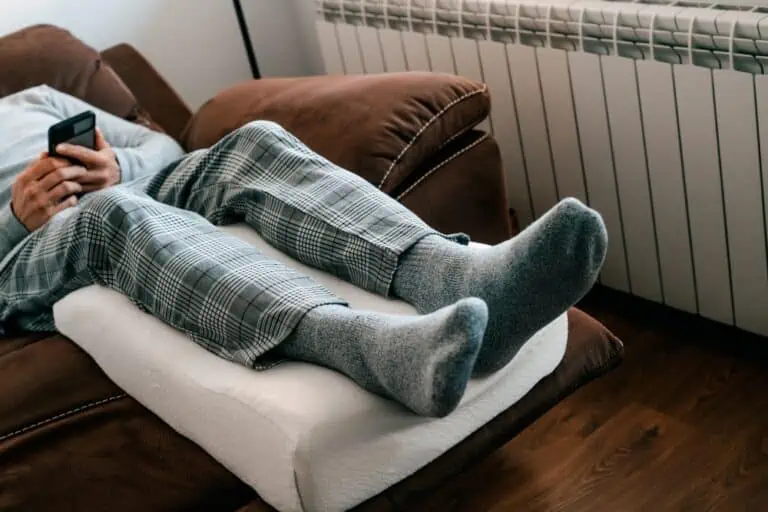Vein Condition
Deep Vein Thrombosis
What Is Deep Vein Thrombosis?
Deep vein thrombosis or DVT, is when a blood clot forms in a deep vein (one that’s not near the skin).
DVT usually occurs in the leg but may occur in other areas including the arm or pelvis. It doesn’t always cause symptoms and often goes undiagnosed until there’s a serious complication. If a deep vein blood clot breaks free, it can travel the bloodstream and lodge in the heart or lung. This is a life-threatening situation.
Anyone who may have DVT should be evaluated and treated as soon as possible to prevent or minimize complications such as:
- Pulmonary embolism: A blood clot in the lung
- Post-thrombotic syndrome: Chronic pain, swelling and other symptoms
- Venous ulcers
- Chronic venous insufficiency (CVI)
FAQs
The most common causes of DVT are:
- Vein damage from surgery or trauma
- Inflammation due to infection or injury
- Medical conditions that affect how the blood clots
Another important risk factor is reduced mobility, such as from paralysis, a hospital stay, bed rest or even a long plane or car ride.
DVT is more common with age. Other risk factors include:
- Smoking
- Obesity
- A personal or family history of DVT or pulmonary embolism
- Pregnancy
- Oral contraceptives or hormone replacement therapy
- Dehydration
- Heart failure
- Inflammatory bowel disease
- Varicose veins
The more risk factors you have, the higher your risk of DVT. But sometimes, there’s no clear cause.
The most common signs and symptoms of DVT are:
- Swelling of the leg together with calf pain
- Skin that’s red and warm to the touch
About half of people with DVT have no obvious symptoms.
The most serious complication of DVT is a pulmonary embolism, which can cause:
- Breathing problems
- Chest pain that worsens with a deep breath
- Dizziness and fainting
- Rapid pulse and heartbeat
- Hemoptysis (coughing up blood)
A pulmonary embolism is a medical emergency. If you have symptoms of a PE, seek immediate medical care.
The doctor will ask about your symptoms and medical history and examine the affected area to check for redness, tenderness and swelling.
Tests that can help confirm or rule out DVT include:
- Duplex ultrasound, which uses sound waves to detect blood flow abnormalities
- Magnetic resonance venography (MRV), a type of MRI that produces three-dimensional images of veins
- D-dimer test, a blood test that can help rule out DVT. D-dimer is a protein produced by blood clots. Most people with DVT have a high level of D-dimer.
Because DVT is so common and often causes no symptoms, it’s been called a silent epidemic. These steps can help lower the chances of developing DVT:
- Don’t smoke.
- Exercise regularly.
- Manage your weight.
- Stay hydrated.
- Avoid tight-fitting clothing that can restrict blood flow, especially when traveling.
- If you’ve been in the hospital or on bed rest, start moving around as soon as you’re able.
- When traveling, drink plenty of water and avoid alcohol.
- Try not to sit still for too long. When possible, get up and move around at least once every hour or two.
- Avoid crossing your legs.
Try these exercises to promote blood flow while seated:
- Keeping your toes on the floor, raise and lower your heels 10 times. Then raise and lower your toes while keeping your heels on the floor.
- Tighten your calf muscles and hold for 5 seconds. Release and repeat several times.
- Lift one foot off the floor. Trace clockwise circles with your toes for a few seconds. Switch direction and repeat. Repeat with the other foot.
Talk to your doctor about your risk factors for DVT and how you can reduce your risk.
Treatments for Deep Vein Thrombosis
The goal of treatment is to prevent the clot from getting bigger or breaking loose and traveling to the lungs or heart. Your treatment plan will also include strategies to lower the chances of developing another DVT. Treatment options may include:
Anticoagulants (Blood Thinners)
These drugs help the body break up the clot. Blood thinners for DVT include oral, IV and injectable drugs. DVT patients may remain on them for months or years.
Vena Cava Filter
In an outpatient procedure, the physician inserts a tiny filter into the vena cava, the largest vein in the body. The device is left in place. If a blood clot breaks away, the filter will prevent it from reaching the lungs or heart.
Intravascular Ultrasound
Intravascular ultrasound (IVUS) is a noninvasive diagnostic imaging technique that uses sound waves to create detailed images of the inside of blood vessels. The technology can be used to evaluate veins in the legs, pelvis and abdomen.
Angioplasty and Vein Stent
If an abnormality of the vein is identified using IVUS, this is a treatment option. Angioplasty widens the vein with a balloon to improve the blood flow. Once the vein is widened, the surgeon may insert a wire mesh, or stent, to help keep it open.
Thrombolytics
These fast-acting, clot-busting drugs can be administered intravenously or directly into the clot through a catheter.
Venous Thrombectomy
In rare cases, a clot may be removed surgically.
If you have DVT or had it in the past, your vein specialist may recommend wearing compression stockings to help prevent blood from pooling or clotting.
What Causes Swollen Legs and When Should I Worry?
There are dozens of possible reasons for swollen legs — everything from sitting too long to serious heart or kidney problems.
If your legs, ankles or feet have started to look like sausages, learn the main causes of leg swelling and when to see a vein specialist.
